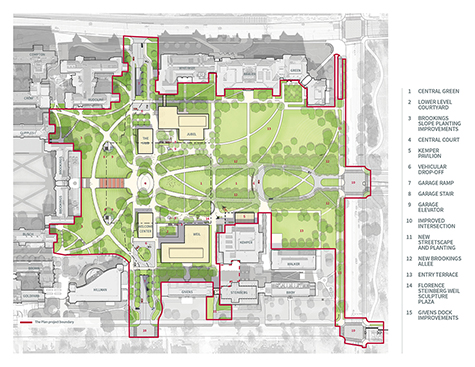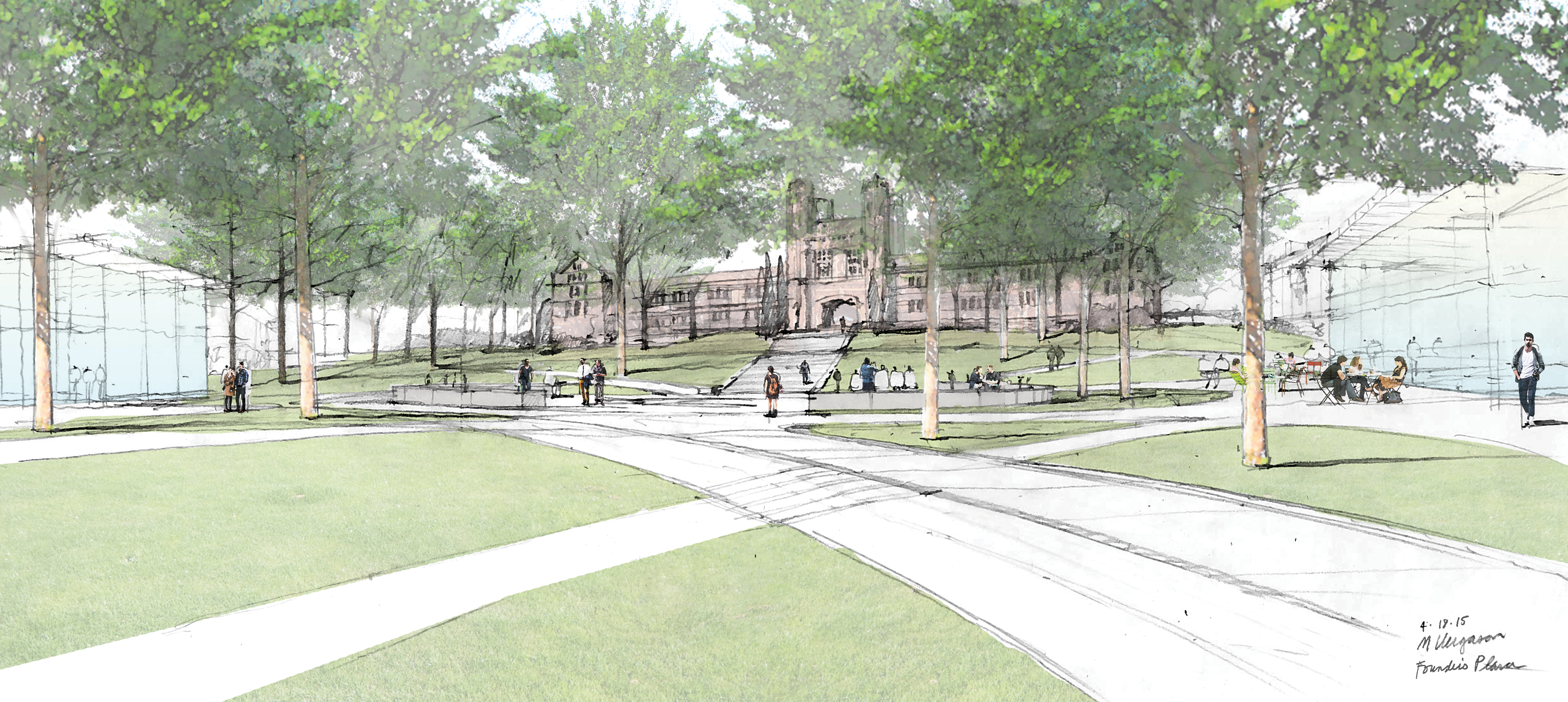In 2017, Washington University in St. Louis will begin one of the most significant capital projects in the recent history of the Danforth Campus: transformation of the east end. The comprehensive plan includes new academic facilities, to support the university’s core missions of teaching and research, and expansive green space that better connects academic programs and provides a more inviting, relaxed gathering place for the university community and visitors to campus.
“For many years, we have envisioned ways to harness the potential of this prominent part of the Danforth Campus,” said Chancellor Mark S. Wrighton. “The comprehensive plan approved by the board not only embraces our history and tradition — with roots grounded in original concept design from the 1900s — it also has an eye toward the future, furthering our role as a world-class teaching and research institution.
“We are excited to see this vision become a reality.”
Key components of the plan are:
- Henry A. and Elvira H. Jubel Hall — Set to house the School of Engineering & Applied Science’s Department of Mechanical Engineering & Materials Science (MEMS), Jubel Hall will offer infrastructure and research facilities that are key to fostering the interdisciplinary nature of engineering.
- Anabeth and John Weil Hall — Weil Hall will be a symbol of the university’s commitment to creativity in the 21st century and will identify the Sam Fox School as a leader in design practice and education. This new front door to the Sam Fox School will express the important roles for art and architecture in a research university and will help guide the future of these disciplines.
- Welcome Center and the Hub: Two new interdisciplinary pavilions framing Brookings Hall — The Welcome Center will offer all visitors a home base for their campus experience and will house Undergraduate Admissions. The Hub, open to the campus and broader communities, will bring together dining, alternative transportation support and academic programming.
- Mildred Lane Kemper Art Museum lobby and gallery — An addition on the north side of the Kemper Art Museum will establish a transparent and welcoming entry for the community as well as create additional gallery space to showcase a larger portion of the museum’s renowned collection. The project also will include renovations integrating the Florence Steinberg Weil Sculpture Garden into the landscape of the east end of the Danforth Campus.
- Underground parking facility — A nearly 800-space underground parking garage will allow for the elimination of surface parking and vehicular traffic from the east end of the Danforth Campus, make it possible for the building and landscaping projects to proceed, and ensure a safer and more pleasant experience across campus for pedestrians and bicycle traffic.
- Transformative landscape — The new east end of the Danforth Campus will offer both a welcoming entrance and places to gather and celebrate. Landscaping will honor the historical design of the Danforth Campus and offer an enhanced, tree-lined frame of Brookings Hall while improving pedestrian access into and across the Danforth Campus. The landscape design will bring most of the east end to the same elevation, limiting the need for stairs and ramps and offering a more accessible entrance to the university. At the heart of the new development of the east end of the Danforth Campus will be a beautiful and inviting new campus gathering place, the Central Green.

(Click image to download larger size) (Credit: michael vergason landscape architects)
“Through this project, the university is converting an area that’s been dominated by parking lots into a hub for state-of-the-art research and academic facilities and a vibrant, energetic green space,” said Henry S. Webber, executive vice chancellor for administration.
“It will become a central part of campus life — connecting people and place in entirely new ways.”
For the School of Engineering, the enhancements to the east end of the Danforth Campus will allow the school to expand its Mechanical Engineering & Materials Science program and support collaboration across departments and schools.
“In Jubel Hall, mechanical engineers will work closely with physicists, chemists, biologists, and chemical and biomedical engineers to promote the convergence of mechanics, materials science and nanotechnology,” said Aaron F. Bobick, PhD, dean and the James M. McKelvey Professor.
“Our new facilities will accelerate progress toward cleaner energy, better health care, and a more secure nation through research in biomechanics, energy, aerospace and advanced materials,” he said.
Weil Hall will support the Sam Fox School’s growing graduate programs, including the relocation of the Master of Fine Arts (MFA) program to the Danforth Campus. The new facility on the east end of Danforth also will feature exceptional spaces for the generation, experience and dissemination of art and design.
“Weil Hall will be an inspiring place for advanced scholarship, creative activity, innovative research and bold experimentation as faculty and students seek solutions to critical social and environmental challenges,” said Carmon Colangelo, dean and the E. Desmond Lee Professor for Collaboration in the Arts.
“Our new facility, the planned landscape and its systems will be both an important teaching tool and an interdisciplinary hub.”
Fabrication and maker spaces in Weil and Jubel halls will provide tools and technologies for students from all disciplines to take an idea from design to prototype, creating an important interdisciplinary connection across the new east end of the Danforth Campus.
Next steps
The university will finalize designs for the transformation of the east end of campus by 2017 and will begin construction in May 2017 with completion in May 2019.
During the design phase of the project, the university will be working closely with its construction manager, McCarthy Building Companies Inc., to most efficiently manage parking and traffic disruptions over the time span of the project.
More information and project updates will be available at campusnext.wustl.edu.
